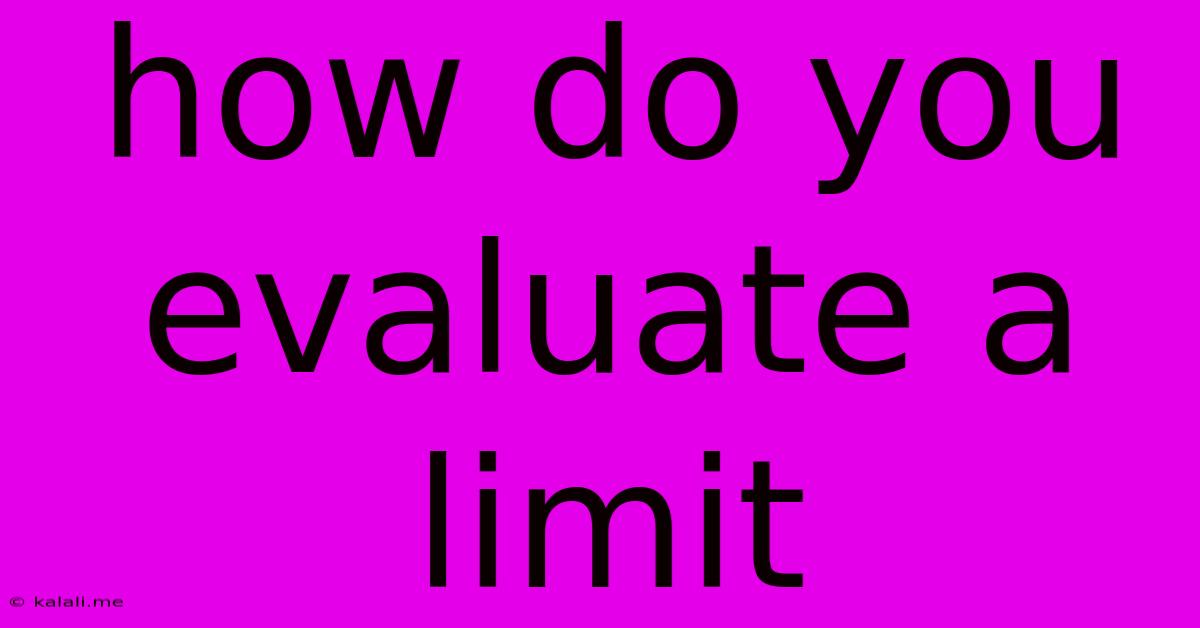How Do You Evaluate A Limit
Kalali
May 30, 2025 · 3 min read

Table of Contents
How Do You Evaluate a Limit? A Comprehensive Guide
Evaluating limits is a fundamental concept in calculus. Understanding how to evaluate limits allows you to analyze the behavior of functions as they approach specific values, crucial for understanding continuity, derivatives, and integrals. This guide will walk you through various techniques for evaluating limits, from simple substitution to more advanced methods like L'Hôpital's Rule.
What is a Limit?
Before diving into evaluation techniques, let's clarify what a limit is. Informally, the limit of a function f(x) as x approaches a (written as lim<sub>x→a</sub> f(x)) is the value that f(x) gets arbitrarily close to as x gets arbitrarily close to a. It's important to note that the function doesn't necessarily have to be defined at a for the limit to exist.
Methods for Evaluating Limits
Several methods exist for evaluating limits, and the best approach depends on the function's characteristics.
1. Direct Substitution:
This is the simplest method. If the function is continuous at x = a, simply substitute a for x in the function. If the result is a defined real number, that's your limit.
- Example: lim<sub>x→2</sub> (x² + 3x - 2) = (2)² + 3(2) - 2 = 8
2. Factoring and Simplification:
When direct substitution leads to an indeterminate form (like 0/0 or ∞/∞), factoring and simplification can often resolve the issue. Factor the numerator and denominator, cancel out common factors, and then try direct substitution again.
- Example: lim<sub>x→1</sub> (x² - 1)/(x - 1) = lim<sub>x→1</sub> (x - 1)(x + 1)/(x - 1) = lim<sub>x→1</sub> (x + 1) = 2
3. Rationalizing the Numerator or Denominator:
For expressions involving radicals, rationalizing can help eliminate indeterminate forms. Multiply the numerator and denominator by the conjugate of the expression containing the radical.
- Example: lim<sub>x→0</sub> (√(x+1) - 1)/x. Multiplying by the conjugate (√(x+1) + 1)/(√(x+1) + 1) simplifies the expression to lim<sub>x→0</sub> x/ (x(√(x+1) + 1)) = lim<sub>x→0</sub> 1/(√(x+1) + 1) = 1/2
4. L'Hôpital's Rule:
This powerful rule applies to limits of the form 0/0 or ∞/∞. If the limit of f(x)/g(x) is indeterminate, and both f(x) and g(x) are differentiable, then the limit is equal to the limit of the ratio of their derivatives: lim<sub>x→a</sub> f(x)/g(x) = lim<sub>x→a</sub> f'(x)/g'(x). You may need to apply L'Hôpital's rule multiple times for some functions.
- Example: lim<sub>x→0</sub> (sin x)/x. Applying L'Hôpital's rule gives lim<sub>x→0</sub> (cos x)/1 = 1.
5. Squeeze Theorem (Sandwich Theorem):
If you can bound a function f(x) between two other functions, g(x) and h(x), such that g(x) ≤ f(x) ≤ h(x) and lim<sub>x→a</sub> g(x) = lim<sub>x→a</sub> h(x) = L, then lim<sub>x→a</sub> f(x) = L.
- Example: This theorem is often used to prove lim<sub>x→0</sub> (sin x)/x = 1.
6. Trigonometric Identities and Limits:
Knowing common trigonometric limits and identities (like lim<sub>x→0</sub> (sin x)/x = 1) can greatly simplify the process.
7. Infinite Limits:
When evaluating limits involving infinity, consider the behavior of the function as x approaches positive or negative infinity. Analyze the highest power terms in the expression to determine the limit.
Conclusion:
Evaluating limits involves a variety of techniques, and selecting the appropriate method is crucial. Mastering these techniques is fundamental for further progress in calculus and related fields. Remember to always check for indeterminate forms and consider using algebraic manipulation, L'Hôpital's rule, the squeeze theorem, or trigonometric identities to evaluate the limits accurately. Practice is key to mastering these techniques and building a strong foundation in calculus.
Latest Posts
Latest Posts
-
How To Make Yellow With Rgb
May 31, 2025
-
How Heavy Is 50 Feet Of Rope
May 31, 2025
-
Google Sheet Print Selection As Csv
May 31, 2025
-
Chopin Waltz In C Sharp Minor
May 31, 2025
-
What Flew Over Charlotte Nc Last Night
May 31, 2025
Related Post
Thank you for visiting our website which covers about How Do You Evaluate A Limit . We hope the information provided has been useful to you. Feel free to contact us if you have any questions or need further assistance. See you next time and don't miss to bookmark.